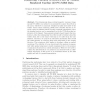Free Online Productivity Tools
i2Speak
i2Symbol
i2OCR
iTex2Img
iWeb2Print
iWeb2Shot
i2Type
iPdf2Split
iPdf2Merge
i2Bopomofo
i2Arabic
i2Style
i2Image
i2PDF
iLatex2Rtf
Sci2ools
102
click to vote
BILDMED
2016
2016
Enhancing Visibility of Blood Flow in Volume Rendered Cardiac 4D PC-MRI Data
Abstract. Four-dimensional phase-contrast magnetic resonance imaging (4D PC-MRI ) is a method to non-invasively acquire blood flow in the aorta. This flow is commonly visualized as path lines inside of the vessels. Direct volume rendering (DVR) uses a transfer function to directly render the dataset without needing a manual segmentation. Since the transfer function can be manipulated on the fly, DVR allows fast exploration of the dataset. Using a simple intensity-based transfer function, however, either the intravascular blood flow would be hidden behind the vessel’s front side or the entire vessel has to be culled from the visualization. Therefore, we propose an automated mechanism that reveals the vessel anatomy by removing their front sides based on the viewing direction. This creates an effect similar to frontface culling on surface renderings. The visibility of focus objects inside the anatomy is guaranteed while spatial awareness is mostly maintained due to the presence of...
| Added | 30 Mar 2016 |
| Updated | 30 Mar 2016 |
| Type | Journal |
| Year | 2016 |
| Where | BILDMED |
| Authors | Benjamin Behrendt, Benjamin Köhler, Uta Preim, Bernhard Preim |
Comments (0)

